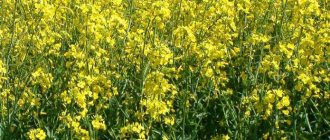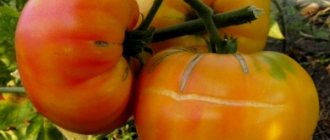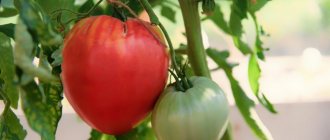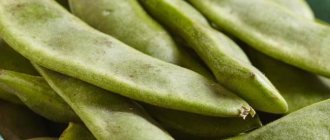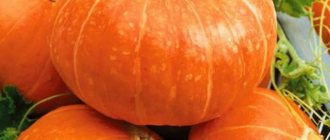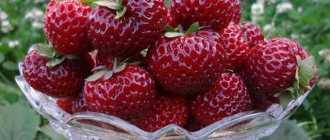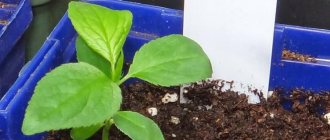What is zucchini?
This is a variety of zucchini with emerald green or bright yellow skin and white flesh. It was first developed in the early 1800s in Italy.
Zucchini is harvested before it is fully grown and ripe. During this period, the vegetable is completely edible: peel, seeds and pulp.
What does zucchini look like - photo of the plant
The shade of green zucchini skin varies from light to dark. Upon closer examination, you can see small golden spots on it.
Zucchini is usually cylindrical in shape, but there are also round varieties. In addition to green varieties, there are bright yellow and “golden” varieties.
The best varieties of crops
Zucchini: growing and caring in open ground
A huge number of varieties have been bred, all of them differ in color, shape, and ripening period. Let's take a closer look at the most popular ones.
- Black Beauty is a variety with long fruiting and high yield. The color of the fruit is dark green, almost black, has a glossy surface, weight can reach up to 1 kg. In the middle it is light and dense, and the taste is delicate, which does not deteriorate even after canning.
- Jade is a mid-season variety that was bred a little over 10 years ago. The fruits have a green tint with a smooth surface and weigh up to 1.2 kg. The variety has pale cream-colored flesh that is fibrous but very tasty.
- Tintoretto is an early variety characterized by a round shape. The color is yellow with a speck, the weight of one representative reaches up to 2 kg. It is in demand among summer residents due to its high yield.
- Zebra is a high-yielding and very early variety. The vegetable is pale green in color with longitudinal dark green stripes. It is well stored and transported without losing its presentation. Its main feature is that it is frost-resistant, actively grows and bears fruit even in cold climates.
- Golden scallop is perhaps the most non-standard and not very attractive in shape, but the most dietary variety of zucchini. It has an average ripening period. In appearance it resembles a yellow pear with a lumpy surface. The weight of the Golden scallop reaches up to 2 kg. It is consumed both fresh and canned for the winter. Under optimal conditions, it is perfectly preserved until the next harvest.
- Banana is another unusual variety of zucchini. It received this name because of its appearance. The fruits grow golden-orange up to 25 cm long. The variety has dense, slightly yellow flesh with a juicy taste. It also stores and transports well.
- Tiger Cub is an early ripening variety. Its main difference from others is its active development and growth. The color is striped. Zucchini of this variety is stored for a long time, but does not lose its taste. They can be canned, frozen, and consumed with proper nutrition because they contain a lot of potassium, fiber, phosphorus, calcium and vitamins B and C. 100 g of zucchini contains only 16 kcal, which is 40% less than Brussels sprouts and broccoli.
Zucchini is a tasty and healthy vegetable that can be used to prepare a variety of dishes. They are marinated, stewed, fried, stuffed, caviar, compotes, candied fruits are prepared from them, and zucchini casserole will become the queen of any table. But in order to enjoy an environmentally friendly product, you need to choose the appropriate variety and grow it correctly on the site.
How is it different from zucchini?
These two varieties of the same plant are often confused with each other.
The main difference between zucchini and zucchini is the color of the peel. Otherwise there is practically no difference. Zucchini is shiny, dark green or yellow on the outside and pale on the inside. Zucchini skins are pale green. It is believed that zucchini tastes more tender.
Zucchini and zucchini are the same plant, just with different names.
general characteristics
Zucchini is an early ripening member of the pumpkin family, which is the closest relative of zucchini. By the way, the name of this fruit comes from the Italian “zucca”, meaning “pumpkin” [1]. They differ from other representatives of the zucchini genus by their very delicate green or yellowish skin and juicy, crispy white flesh. The main difference between zucchini and zucchini is faster ripening (vegetables can be harvested 4-7 days after the ovary appears). There is also a noticeable difference in the size of both fruits: zucchini is usually larger, and the ideal size for zucchini is 15 cm. Another advantage of zucchini: despite the fact that the chemical composition of all types of zucchini is very similar, this variety is absorbed by the body much easier.
Content:
- general characteristics
- Nutritional characteristics
- Benefits for the body
- Use in folk medicine
- Possible hazardous properties
- Vegetable for beauty
- Use in cooking
It is believed that the first zucchini appeared in South America 10 thousand years ago. In those ancient times, wild zucchini was significantly different from the ones we are used to eating today. South American tribes used these ancient squashes primarily for their seeds, as their flesh was quite bitter.
In the 16th century, zucchini, thanks to the conquistadors, crossed the ocean and came to Europe. Researchers suggest that it was the Italians who were the first to “domesticate” this green overseas guest and learned to prepare the most incredible delicacies from it. And in the 18th century in Europe, young zucchini began to be consumed with might and main. And since the vegetable came to Russia from Italy, it is not strange that for many years it was called Italian zucchini here.
Today, this vegetable is an indispensable component of low-calorie diets, as it has a very low glycemic index. Due to their high water content, zucchini contains virtually no calories, but is a good source of some minerals and vitamins [2]. Cooks also love this product. Zucchini lends itself well to almost any cooking method.
Where to buy and how to choose
Zucchini is sold throughout the year in large supermarkets. But it is best to buy them in season - from June to August. During the summer months, zucchini can be found at farmers' markets.
They should be firm to the touch with a smooth skin, without stains or severe damage. Minor scratches and light dents on the surface are common.
Avoid large zucchini as they are tasteless, have tough flesh and hard seeds. The best size is 15 to 20 cm in length and 5-7 cm in diameter.
Avoid zucchini with soft or wrinkled ends as these indicate staleness and loss of moisture.
The color may vary depending on the variety. It doesn't matter if the zucchini is green, orange or yellow - they have the same taste and cooking method.
How and how much to store
The skin of young zucchinis is quite delicate, so handle them carefully. Store them in an open plastic bag in the vegetable drawer of the refrigerator for up to a week. Do not wash the zucchini until you are ready to use it. The shelf life under such storage conditions is up to a week. If you notice signs of wilting, immediately start preparing dishes with zucchini.
Zucchini can be frozen. To do this, cut it into cubes or grate it, put it in a bag or container and put it in the freezer. Frozen vegetables will usually keep in the freezer for about a year.
Please note that frozen zucchini becomes very soft after thawing, and its texture is more suitable for making soups or vegetable stews.
Landing Features
There are two methods of planting: using seedlings or seeds. The choice of planting option depends on the climate in which you live, as well as the desired harvest date. If there is no need to quickly harvest the fruits, you can sow zucchini seeds directly into the soil. But before this, you need to prepare the soil: dig small holes at a distance of about 70 cm from each other, then fertilize them with humus or compost, and then you can sow the seeds. After about a month, the plant will bloom.
Seeds should be sown between late May and early June. It is recommended to sow not in extreme heat, but also not in cold, for the reason that if the temperature drops below -2 degrees, the zucchini may die.
If you want to plant seedlings, then this is done in this way: a mixture of humus and peat is added to special planting containers or pots. Then the substance is lightly watered, the seeds are laid out on it and sprinkled with soil mixture (to form a layer of about 2-3 cm). Water the seedlings every 10 days. During the growth of seedlings, it is necessary to feed the plants twice: when the first shoots appear and 10 days after that. “Bud” or “Agricola” are most often used as fertilizer.
Note! It is necessary to sow zucchini seeds for seedlings 30-35 days before planting them in open ground.
Use in cooking and recipes
Zucchini is usually fried (plain or breaded), baked in the oven or grilled along with other vegetables - eggplant, peppers, carrots and potatoes. Popular recipes include ratatouille, pancakes and stuffed baked zucchini.
Zucchini is also pickled and eaten raw in salads.
Preparation and cutting
Wash the zucchini, then cut off the stem and top. You can leave the peel: it has a lot of fiber and nutrients, and it is tender and soft.
Zucchini can be cut however you like:
- thick slices (circles) – great for grilling or steaming;
- semi-slices or cubes - good for frying;
- cubes - for stewing and soups.
Methods for cutting zucchini
When cooked, zucchini produces a lot of juice and quickly becomes too soft. To maintain texture, cut the zucchini in half before cooking and sprinkle the halves liberally with salt. After a couple of minutes, droplets of moisture will appear on the surface. After about 5 minutes, wipe off all the salt and liquid. This helps draw out excess water from the zucchini.
Seasonings for zucchini
Because of its neutral flavor, zucchini goes well with herbs and spices. Suitable seasonings:
- basil;
- thyme;
- oregano;
- rosemary;
- garlic;
- smoked paprika;
- Cayenne pepper.
If you want to highlight the natural taste of zucchini, just add a little salt and pepper.
Zucchini flowers are also edible
The golden tubular florets of the zucchini plant are very popular in Italy, where they are stuffed with ricotta and thyme and then fried or baked. In Mexico, the petals are used in quesadillas and soups. Zucchini flowers are also eaten raw.
Fried zucchini with garlic
Ingredients:
- 2 medium zucchini;
- 2 tsp. olive oil;
- 1 tsp. butter;
- 3 cloves of garlic;
- ¼ tsp. salt;
- ¼ tsp. pepper
How to cook:
- Cut the zucchini into 0.5-0.6 cm slices.
- Place a large frying pan over medium heat and add oil.
- After a minute, add the zucchini and cook, stirring occasionally, until the vegetables are soft.
- Add seasonings - chopped garlic, salt and pepper.
- Stir and after a minute remove from heat and serve.
How to cook zucchini in the oven with cheese
Ingredients:
- 2 medium zucchini;
- 2 tbsp. l. butter;
- 1 tbsp. l. mixtures of oregano, salt and pepper;
- Parmesan cheese for sprinkling.
Step-by-step instruction:
- Cut the zucchini into 1cm thick slices (they can also be quartered lengthwise and then halved, as for French fries), and place in a small bowl.
- Melt the butter and pour over the zucchini pieces. Add seasonings and stir.
- Place zucchini in a single layer on a greased baking sheet.
- Sprinkle generously with Parmesan cheese.
- Preheat the oven to 170°C and bake for 35-40 minutes. You'll know it's ready when the zucchini turns golden brown.
Cooking recommendations
In general, both vegetables are interchangeable and can be used in the same dishes. Cooking instructions, however, will vary.
Regarding zucchini, you should pay attention to the following tips from experienced chefs:
- Young fruits will have the most delicate taste;
- a win-win option would be fried rings, stew, casserole and squash caviar;
- less common, but extremely tasty dishes are stuffed zucchini wedges, deep-fried cubes and risotto with this vegetable.
It is better to cook zucchini, paying attention to the following recommendations:
- All the recipes listed above are suitable for this product, including stuffing and deep-frying;
- they can be added raw to salads - the dish will have an unusual and pleasant taste;
- the raw product, cut into cubes, can be served along with carrots, celery and hot sauce - this appetizer is called pincimonio and is an excellent option for parties.
Important! Before cooking, vegetables should be washed and dried naturally or with a napkin.
Zucchini and zucchini are foods that have many different traits. However, these vegetables belong to the same species and have many positive characteristics. When prepared correctly, dishes made from these products will take pride of place on your table.
The benefits and harms of zucchini
Zucchini is healthy because it is rich in nutrients, has a low glycemic index (15 units), a high percentage of water and low calorie content (17 kcal). But even in this case there were some disadvantages and limitations.
Beneficial features
- Improves Digestion – Zucchini is high in water, fiber, electrolytes and other nutrients needed for a healthy digestive system. Regular consumption helps prevent ulcers, IBS and colon cancer, and reduces the incidence of constipation and other gastrointestinal problems.
- Zucchini is rich in antioxidants and anti-inflammatory phytonutrients that rid the body of free radicals and excess inflammation. This beneficial property improves immunity and protects against many diseases.
- Supports circulation and cardiovascular health thanks to its high potassium content.
- Improves eye health as zucchini is a good source of health-promoting antioxidants and phytonutrients including vitamin C, beta-carotene, manganese, zeaxanthin and lutein.
- Increases energy because it is rich in B vitamins, which the body requires for protein and carbohydrate metabolism.
- Improves the functions of the thyroid gland and adrenal glands.
For diabetes
Lowers blood sugar levels as eating zucchini increases fiber intake.
When losing weight
Because zucchini is low in calories, high in water and fiber, it is a great food for those looking to lose weight.
During pregnancy and lactation
Since zucchini contains a lot of beta-carotene, too much of it (several pieces daily) is undesirable for pregnant and lactating women.
Use in folk medicine
One of the main advantages of this vegetable is that it does not cause allergies, so it is considered useful even for the smallest children and people prone to food allergies. The benefits for allergy sufferers don't end there. Herbalists recommend taking a decoction of the flowers of the plant as a medicine against allergies.
For anemia and problems with the heart or blood vessels, traditional healers advised drinking freshly squeezed zucchini juice, but not more than 100-150 ml per day (the first time the portion may be even smaller), since large portions can cause stomach upset. It is useful to consume this vegetable as a natural medicine for men, in particular those who have been diagnosed with prostate diseases.
Raw zucchini seeds are used as an anthelmintic, and an alcohol tincture made from them is useful for calming the nerves and relieving tension.


